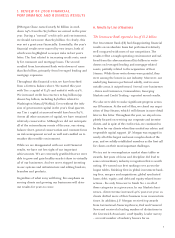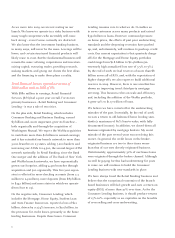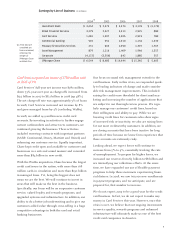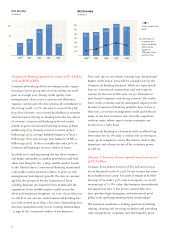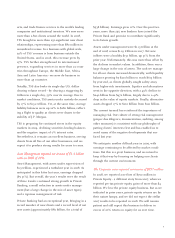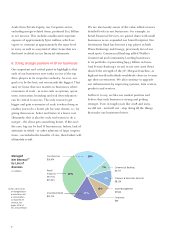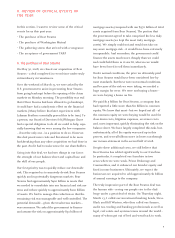JP Morgan Chase 2008 Annual Report Download - page 15
Download and view the complete annual report
Please find page 15 of the 2008 JP Morgan Chase annual report below. You can navigate through the pages in the report by either clicking on the pages listed below, or by using the keyword search tool below to find specific information within the annual report.13
We think the government acted boldly in a very tough
situation, the outcome of which could have possibly been
far worse had it not taken such steps
The government acted quickly and boldly – taking
unorthodox steps to try to right the ship. It had to act
with urgency while dealing with complex and rapidly
changing problems that did not lend themselves to
simplistic solutions. While we will never actually
know, we believe, as many economists and analysts do,
that without these and other actions the government
has taken to date, things could have been much worse.
So while it is easy to criticize the timing, marketing or
consistency of the effort – we also recognize how hard
it is to act boldly in difficult and dangerous times. We
should remind ourselves of what President Theodore
Roosevelt expressed nearly a century ago:
“It is not the critic who counts; not the man who points
out how the strong man stumbles, or where the doer of
deeds could have done them better. The credit belongs
to the man who is actually in the arena, whose face is
marred by dust and sweat and blood; who strives
valiantly; who errs, who comes short again and again,
because there is no effort without error and shortcom-
ing; but who does actually strive to do the deeds; who
knows great enthusiasms, the great devotions; who
spends himself in a worthy cause; who at the best
knows in the end the triumph of high achievement, and
who at the worst, if he fails, at least fails while daring
greatly, so that his place shall never be with those cold
and timid souls who neither know victory nor defeat.”
We hope that our leaders will continue to be bold
and brave in seeking solutions to these once-in-a-
generation problems.
Banks are lending, and the TARP is probably helping
It is important to recognize that TARP capital is only
14% of our total capital. It is also important to recog-
nize that to the extent we use the money and lose it,
the risk is 100% ours because we still owe the money
back to the government. Despite that, we, and other
banks, are trying to use TARP capital to benefit share-
holders, clients and communities. In the fourth quarter
of 2008 alone, we extended more than $150 billion in
new credit to consumers, businesses, municipalities
and not-for-profit organizations, including nearly $30
billion in home lending and $2.8 billion in auto lend-
ing. We increased loans and commitments to govern-
ment units, health care companies and not-for-profits
by 33% in 2008 and plan to increase lending to these
groups by $5 billion in 2009. We also completed sever-
al major syndicated leveraged finance loans, and, in
one critical instance, we bought the entire $1.4 billion
bond issue from the state of Illinois when no one
else would bid for it, giving Illinois the financing for
payroll and other important needs. Finally, we remain
very active in the interbank market (where banks lend
to each other) and have had on average $40 billion to
$50 billion out in the interbank market each night.
While total lending by banks fluctuates according to
the markets and changing credit conditions, we do
believe that TARP has enabled many banks to increase
their lending in certain key areas – more than they
otherwise would have done.
While we clearly understood that there might be
potential (mostly political) unintended consequences
of TARP, we believed that it would help the U.S.
financial system at that critical moment.


